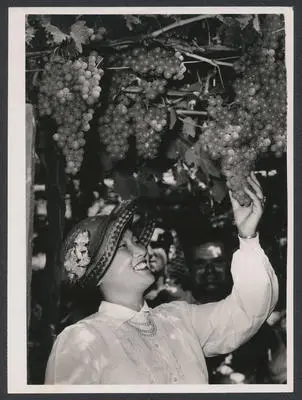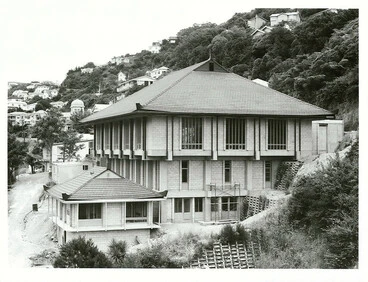Chinese New Zealanders 1940s-2020s: new worlds
A DigitalNZ Story by National Library Services to Schools
Today Chinese New Zealanders live in vibrant and diverse communities. Some Chinese traditions are now popular mainstream events while Chinese New Zealand writers and artists are increasingly exploring their contemporary and generational histories.
Fruiterer Peter Chong
Manatū Taonga, the Ministry for Culture and Heritage
BACKGROUND: CHINESE NEW ZEALANDERS, 1940s-2020s
Today, Chinese communities are vibrant and diverse. Some Chinese traditions are now popular mainstream events while Chinese New Zealand writers and artists are increasingly exploring their contemporary and generational histories.
CONTENT
- The war years (1939 — 1945)
- Post-war social changes
- Supporting resources: Post-World War 2
- A new wave of migration: 1987 onwards
- Supporting resources: 21st century
- Supporting resources: General
- Glossary
THE WAR YEARS (1939 — 1945)
World War 2 helped improve Aotearoa New Zealanders’ attitudes towards its own Chinese community. In the public mind, China became a valued wartime ally, and this had positive impacts at home. Vegetable growing was deemed an essential industry during World War 2.
The New Zealand Government valued the Chinese community’s role in vegetable production and sought their help in supplying US troops in the Pacific with produce. This prompted the formation of the Dominion Federation of New Zealand Chinese Commercial Growers.
Chinese families reunited
The war also impacted families. Partly because of immigration restrictions, many Chinese New Zealand men still had wives and children in China. Many became trapped in war zones. In 1939 the New Zealand Government granted 500 wives and children temporary refugee status. Their arrival marked the start of a happier and more anchored Chinese New Zealand community. Family life grew along with the number of Chinese women. Even so the gender balance took until the 1980s to equalise.
Chinese children learning Chinese
Alexander Turnbull Library
POST-WAR SOCIAL CHANGES
Post-war social changes and an economic boom meant greater security and standing in the community which enabled families to prosper. The rise in socio-economic status, however, came at the same time as pressure to become more "Pākehā" in the name of ‘assimilation.’ By the 1960s many offspring had become successful professionals.
Sources: Chinese — Post-war changes, Te Ara - the Encyclopedia of New Zealand. CC BY-NC 3.0 NZ. Information added.
SUPPORTING RESOURCES
Post-World War 2
Chinese refugees arrive at Auckland— the first group of Chinese refugees brought to New Zealand from the war zones by relatives in the Dominion has reached Auckland.
Eating Pork'n'Puha with Chopsticks — this documentary follows four generations of the Lee family, whose whakapapa includes Ngāti Mahuta and Chinese.
Farewell Guangdong: A history book told by its own people — New Zealand Author Lily Lee is from one of the families who descended from the wives and children who fled Guangdong, China, during the second Sino-Japanese War from 1937 to 1945.
Maori-Chinese encounters and New Zealand multicultural society — find out how University of Auckland researcher, Professor Manying Ip, investigated the past and present day dynamics of inter-group relations between the Māori (as Tangata Whenua), and the Chinese (as the archetypical outsider immigrant group).
The New Zealand Chinese Association — since 1935 the Association was established with the specific intention of being a national Chinese organisation that represented and worked for the well-being of the Chinese people in New Zealand.
Plea for more Chinese — a 1976 Government decision to allow 50 relatives of New Zealand families to enter the country has been welcomed by a spokesman for Chinese market gardeners, but a plea was also issued for more such immigrants.
Poll tax apology: To know our history is to know ourselves — Eda Tang explores how the history of Chinese New Zealand can help shape its future.
Post-war changes— China’s fight against the Japanese before and during the Second World War did much to influence public opinion in favour of the Chinese.
The story of Aotearoa New Zealand’s first Chinese refugees— in 1939 a group of Chinese women and children who came to Aotearoa New Zealand.
To grow roots where they land— eyewitness accounts of WW2 Chinese refugees.
Trunk
Museum of New Zealand Te Papa Tongarewa
The New Zealand Chinese Association building
Alexander Turnbull Library
Mrs S. H. Chan with grapes
Auckland War Memorial Museum Tāmaki Paenga Hira
Reverend Peter Fung (right) teaches children from Petone and Lower Hutt their heritage language, Cantonese.
Chinese children learning Chinese
Alexander Turnbull Library
Sun Park Ngan in his fruit and vegetable shop
Palmerston North City Library
NZ Anglican Chinese Mission
Archives New Zealand Te Rua Mahara o te Kāwanatanga
A NEW WAVE OF MIGRATION: 1987 onwards
The new immigrants
The arrival of new Chinese immigrants since the 1980s has resulted in radical changes in the community. The contrast in the community’s profile between the 19th and 21st centuries could not be greater. Now there is a much higher ratio of females to males, as many of the working-age men have returned to earn better money in the booming Asian economies.
The new migrants tend to be well informed and articulate, and therefore less likely to tolerate discrimination. Their desire for recognition and integration has also made them active in philanthropy, local communities, and then national politics.
Source: Chinese — The new immigrants, Te Ara - the Encyclopedia of New Zealand, CC BY-NC 3.0 NZ. Information added.
The ‘Asian experience’
For many non-Chinese New Zealanders, interacting with the local Chinese is often their first Asian experience, whether it be sampling dim-sims, joining a t’ai-chi (taiji) class, or watching a lion-dance during Chinese New Year. The emergence of a vibrant local Chinese culture is a relatively recent phenomenon.
Reviving traditions
Successive waves of new immigrants from the early 1990s reinvigorated many traditions. Chinese New Year and the mid-autumn festival, for example, have become popular celebrations drawing huge crowds of all Aotearoa New Zealanders, Chinese and non-Chinese. Some events, like the lantern festival and dragon boat racing, are now widely popular among other New Zealanders, especially the young.
Source: Chinese — An evolving culture, Te Ara - the Encyclopedia of New Zealand.
Pansy Wong
Manatū Taonga, the Ministry for Culture and Heritage
SUPPORTING RESOURCES
21st Century
Alvin and me — Chris Tse is a New Zealander of Chinese heritage. In this memoir, he talks about his schooldays and what happens when Alvin joins the class, having just arrived in the country from Hong Kong.
Auckland's Lantern Festival — Auckland's Lantern Festival celebrating the Chinese new year is fast becoming Auckland’s biggest cultural event.
The Chinese ethnic group in New Zealand — find 2018 Census data for the Chinese ethnic group.
Chinese New Year — this downloadable book follows Murphy and his family as they prepare for and celebrate Chinese New Year in Aotearoa New Zealand.
Chinese teen migrants talk about living in NZ — students from Macleans College in Howick, Auckland, talk about their parents' reasons for moving to Aotearoa New Zealand and what their first impressions were when they arrived here.
Connecting current events to the past: The Ventnor story — ākonga can use this contemporary story as an entry point for learning about the migration experiences of Chinese New Zealanders.
Julie Zhu — how Julie Zhu found her place in Aotearoa as a Chinese New Zealander.
Meng Foon and the reo of tauiwi — a new bilingual documentary follows race relations commissioner Meng Foon over a year. For the film’s co-director and co-producer, Julie Zhu, tracing his story inspired her to reflect on her own experience as a Chinese learner of te reo Māori.
Reclaiming New Zealand’s Chinese history on stage — Jihee Junn talks to the writer/director of a new play Pork and Poll Taxes about the earliest Chinese New Zealanders – and the families they left behind.
Time for Chinese New Zealanders to be heard — in the past decade or so, New Zealand's Chinese diaspora – from Kiwi-born Chinese to recent immigrants – is taking back the power by authoring their own stories.
What does it mean to be ‘Chinese’ in Aotearoa? — an interview with Ya-Wen Ho.
Lan Yuan Dunedin Chinese Garden
Dunedin Public Libraries
SUPPORTING RESOURCES: GENERAL
But where are you from? — growing up NZ Chinese means being told you don’t look ‘Kiwi’ even if Aotearoa is the only home you’ve known.
EPIC — find more information on Chinese in Aotearoa New Zealand using EPIC. Databases recommended: Australia New Zealand Reference Centre, Bridget Williams Books, NZ History Collection. A login may be required.
Our stories: Chinese histories — provides some examples in the Instructional Series of Chinese histories and also a link to the KNOW element the Aotearoa New Zealand’s histories.
School Journal stories — discover stories articles, plays, poems, etc. relating to Chinese in Aotearoa New Zealand by searching the School Journal database. A login may be required.
Chinese resources — this guide is for scholars, researchers, historians, students, genealogists, and anyone with an interest in Chinese topics.
Chinese New Year celebration, 2008
Manatū Taonga, the Ministry for Culture and Heritage
Traditional Chinese New Year meal, 2006
Manatū Taonga, the Ministry for Culture and Heritage
A lion dance
Manatū Taonga, the Ministry for Culture and Heritage
GLOSSARY
Definitions below have been taken from the Oxford Learner’s Dictionary and Te Aka, the Māori dictionary.
articulate — to express or explain your thoughts or feelings clearly in words.
assimilation — the process of becoming, or allowing somebody to become, a part of a country or community rather than remaining a separate group.
dominion — any of the countries of the British Commonwealth that had their own government.
diaspora — the movement of people from any nation or group away from their own country.
immigration — the process of coming to live permanently in a different country from the one you were born in.
migrants — a person who moves from one place to another in order to find work or better living conditions.
Pākehā — New Zealander of European descent - probably originally applied to English-speaking Europeans living in Aotearoa New Zealand.
reinvigorated — to give new energy or strength to something/somebody.
socio-economic — relating to society and economics.
t’ai-chi — a Chinese martial art and system of exercises consisting of sets of very slow movements.
Here to Stay - The Chinese
NZ On Screen
This story was curated and compiled by Te Puna Mātauranga o Aotearoa | National Library of New Zealand, Services to Schools staff, 2023. We acknowledge the content, research, guidance, and review provided by Kirsten Wong for the New Zealand Chinese Association, Lynette Shum, and Emeritus Professor Dr Manying Ip.
A Levin Market Garden
Kete Horowhenua









